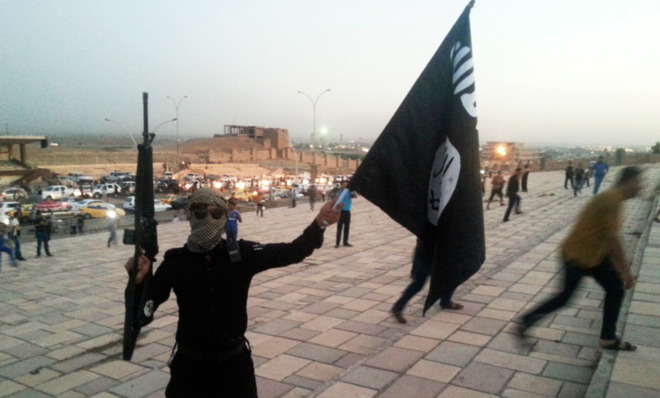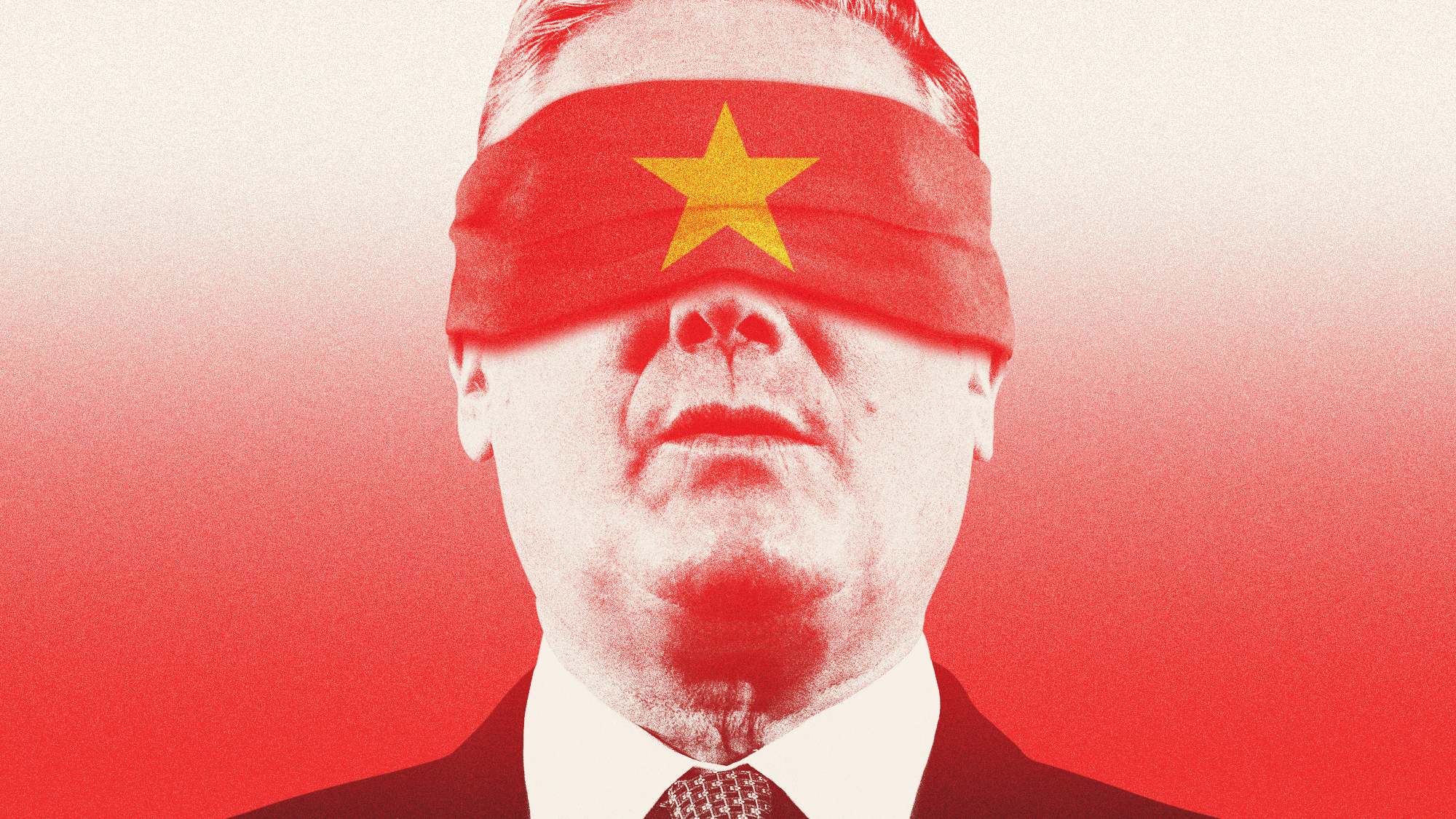How ISIS got jihadi-approved photos on major news sites
Many photos of the militant group's activities are fraught with ethical pitfalls


He's a charismatic figure, the sort that would catch the eye of any good photo editor.
Clad in all black except for the beige kaffiyeh wrapping his face, he stands, arms raised, weapon in one hand, ISIS flag in the other. Through dark aviators, he stares down the camera from just a few feet away.
The picture above, dated June 23, filed by an unnamed photographer, and distributed by Reuters, claims to be of a jihadi militant on the streets of Mosul, two weeks after the Islamic State of Iraq and al-Sham, now called the Islamic State (IS), shocked the world by taking control of Iraq's second-largest city. Time used the image. So did Newsweek, The Daily Beast, The New York Review of Books, and NBC News. And thus, the world got one of its earliest glimpses of Islamic State-controlled Iraq: defiant, in control, triumphant.
The Week
Escape your echo chamber. Get the facts behind the news, plus analysis from multiple perspectives.

Sign up for The Week's Free Newsletters
From our morning news briefing to a weekly Good News Newsletter, get the best of The Week delivered directly to your inbox.
From our morning news briefing to a weekly Good News Newsletter, get the best of The Week delivered directly to your inbox.
The sudden takeover of a wide swath of Iraq by Syria-based militants calling themselves the Islamic State is both one of the biggest stories of the year and one of the hardest for news organizations to cover. The brutality that made ISIS notorious over the course of the Syrian civil war has become a fundamental part of its Iraqi regime. Few journalists have been allowed in by IS's media arms to provide a sense of what life is like under the Islamic State — which is, in part, why a VICE News documentary that premiered Aug. 7, in which filmmaker Medyan Dairieh spent three weeks with the group, has been generating a stir. Most media coverage of the Islamic State's reign has come from areas of relative safety, such as refugee camps in Kurdistan where those fleeing the jihadi advance have taken shelter, or from those embedded with the Iraqi and Kurdish forces fighting against further IS incursions. Few reports have included direct contact with the militants themselves, only with those caught up in their wake.
Except, that is, for the photos.
Iframe Code
A free daily email with the biggest news stories of the day – and the best features from TheWeek.com
Shortly after the takeover, a handful of news agencies, including giants like Reuters and the Associated Press (AP), began sending out pictures from Mosul. Shot by anonymous stringers — that is, freelancers who contribute regularly — the photos reveal daily life under a self-declared caliphate, and depict everything from raucous demonstrations full of fluttering jihadi flags and weapons-filled checkpoints to more mundane scenes of bustling markets. Taken together, they show a combination of breathtaking brutality, widespread support, and a well-functioning state.
(More from Foreign Policy: Do no (more) harm)
They're also fraught with ethical pitfalls. The use of unnamed freelancers by major news organizations in an area ruled by one of the world's most dangerous militant groups has raised a host of questions, from how these agencies can ensure their journalists' safety to whether they can vouch for the methods of the anonymous photographers working for them — or these journalists' relationship with the IS fighters they claim to cover.
And as interviews with a few of the photographers currently working within the caliphate indicate, some agencies are willing to work far outside of traditional journalistic norms in order to provide a window into the world now almost entirely cut off from outsiders, in some cases even sacrificing editorial control to militant jihadists — all in order to get an up-close glimpse of the enemy.
Abu Mirwan — not his real name — has worked as a photographer in Iraq for well over a decade. He is now filing photographs for an international agency, he said in a telephone interview in early August. (He wouldn't say which one). After the IS takeover of Mosul, Mirwan, a Sunni Iraqi, reached out to an agent of the caliphate, who said he could get him permission to work again. The agent was true to his word, Mirwan said. He even shared a pleasant meal with three IS leaders, who told him they would help him by giving him stories and inviting him to see IS events.
The congeniality didn't last long. Mirwan says that a few days later, he was taken to see another member of IS's leadership. It was a very different meeting. The IS leader threatened Mirwan, telling him that if he did anything that damaged IS's reputation, he'd be killed and that if he took any photographs without IS knowledge, he'd be given 100 lashes.
From now on, he was told, before he sent out any photos, he'd have to share his memory cards for approval first.
And that's how he's operated since, Mirwan says. IS invites him to cover events, such as military shows and rallies. He photographs them, with a minder in tow, and when he's through, he clears his images with an IS representative before they go out to either the international agency he works with, or to a local agency he works with which then passes them on to its international contacts.
Mirwan was recruited to document IS's recent attack on the town of Sinjar, he says — the same takeover whose aftermath has prompted U.S. airstrikes in Iraq. There, he was photographing fighting until a few members of ISIS called him over. Thirty men lay waiting facedown on the ground, hands bound behind their backs. Three or four women were standing by, watching. It was an execution.
Take the pictures, he was told.
Mirwan says he's frightened. But the money he makes filing for international agencies is good, he says, and taking photos is the only way he knows to make a living. "I've been doing this job for 15 years," he said. "This is how I support my family."
Iframe Code
Not all imagery coming out of the Islamic State is vetted like Mirwan's. Mohammed (who is also using a pseudonym because he fears IS reprisals) has been working as a journalist for over 10 years and is currently based in Mosul, running a local photo agency, where he has two photographers working under him. In a phone interview in late July, he said his agency sells between seven to 10 photos a day, for about $50 a photo. They work with a variety of different agencies, he says, but mainly with the AP. The agency doesn't know who the stringers supplying its photos are, Mohammed says. He is the AP's only point of contact for his agency's photos.
(More from Foreign Policy: A Kurdish comeback)
Mohammed says his photographers operate without IS permission, snapping furtive images via camera phones and transmitting them out of IS territory by satellite. And not all of AP's Mosul photography has been flattering for IS, in the mode of packed rallies and lively markets: The agency has sent out photos, for instance, of Mosul residents walking over rubble — the aftermath of IS's destruction of the Tomb of Jonah the Prophet, a revered Muslim shrine. Another photo shows an empty park, where a statue of Iraqi poet and cultural icon Adi Tammam once stood.
Mohammed and his photographers do tremendously risky work, but AP is very good to him, he says, and is concerned with his safety: The agency will call to check in on him, and remind him not to take unnecessary risks. But few are willing to take these sorts of chances. Mohammed says he knows of other photographers operating under the same conditions as Mirwan: filing only photos that have been cleared with an IS representative, working out of a TV station in Mosul, who keeps all the images on file.
AP refused Foreign Policy's repeated requests for an interview on its decision to use unnamed stringers in Mosul. However, in an emailed statement, a spokesperson for the agency wrote, "The Associated Press is transparent about the source of images we distribute and the safety of our journalists is paramount."
Over email, a Reuters spokesperson did not respond to a list of nine questions including one about whether the agency knows the identity of its stringers in IS-controlled Iraq, and whether it was comfortable with the requirement that any photographer working in Mosul must appear to support IS. Instead, the agency issued a statement saying it "chooses a mix of staff and stringers to provide the best coverage ... which is hallmarked by its independence and freedom from bias." It balances the use of staff photographers and stringers based on operational requirements, said spokesman Chris Artis, "as well as the deep knowledge of the conflict held by local editors."
News agencies' decisions about whether to rely on stringers in IS territory take place against the backdrop of the intensifying propaganda war unfolding between the Islamic State and the Iraqi government — one that many have argued IS is winning. The group has shown a particular savvy when it comes to brand management: It maintains active social media accounts, regularly publishing images, including the occasional gruesome beheading or mass execution, which are often picked up by news outlets. The militants have a designated propaganda arm, known as the Al Hayat Media Center, which produces high-production videos and a magazine. And reports from other areas under IS control describe similar attempts to control all information bound for the outside world through similar review processes as those described by Mirwan and Mohamed in Mosul: IS set up an "information office" in the Syrian province of Deir Ezzor, for instance. For its part, in response to IS's effective public relations efforts, the Iraqi government has issued a set of "guidelines" for members of the media covering the fight against IS that forbids "broadcast[ing] the messages of armed groups or their savage acts" while exhorting journalists to praise "the heroic acts performed by security personnel," and to "broadcast programs that spread enthusiasm and a fighting spirit against terror." (The guidelines were condemned by humanrights groups as an attempt to prevent critical coverage.)
Iframe Code
Providing anonymity for photographers operating in dangerous territory is a common practice for news organizations, including Reuters and the Associated Press. But the combination of a particularly violent subject, known for its PR savvy, and photographers with whom these agencies have little familiarity and at times almost no contact, is problematic, journalism ethics experts say. By running images from photographers like Mirwan and Mohammed, news organizations open themselves up to charges that they're serving as what Ethical Journalism Network Director Aidan White calls "unwilling foot soldiers" of extremists in this propaganda war. "It's the question of whether or not one is falling into the trap of actually promoting the political interests of" the Islamic State, White said.
(More from Foreign Policy: How the Yazidis changed Obama's thinking on Iraq)
But while news agencies must be aware of the hazards of allowing a dangerous group to depict itself on its own terms, they must also balance against the value of providing public information about an important newsmaker, said Patrick Baz, Middle East and North Africa editor for Agence France-Presse (AFP). AFP hasn't used stringers in IS-controlled Mosul, but it has distributed the group's own images of what it claims to be executions. They're photos that may be intended to intimidate, Baz says, but they also have what he calls "historical value."
"We all know it's propaganda, but we all know at the same time that the world needs to see what's going on," he said. "Our duty is to ring the alarm bell and say, 'Hey guys, this is what's going on. This is what we've found on these guys' website.'"
And conceding some editorial independence for the sake of access isn't a situation unique to the Islamic State, he says. News agencies readily use images distributed by the U.S. army, the Israeli army, or NATO forces, Baz said — decisions that are rarely, if ever, questioned. And military embeds, for instance, often come only after extensive screenings, and with their own restrictions on coverage (though these are typically couched in terms of security, and aren't accompanied by promises of lashings).
In the buildup to the premier of part one of VICE News' documentary, the company touted its journalist's "unprecedented access." Indeed, VICE's cameras appear to go deep into the caliphate, and the footage they capture is chilling: In the first two installments, based in Raqqa, Syria, children as young as 11 pledge loyalty to the caliphate, and IS members give brazen interviews that include pledging to "raise the flag of Allah in the White House." There are also happy scenes, of a sort: Men living under IS rule play with children in a river. And front and center, of course, are the demonstrations of Islamic State power: a tank spinning in circles; IS's signature black flag waving from a turret; a parade of stolen Iraqi weapons; a rally in which a crowd is prodded into a call-and-response: "The Caliphate!" "Established!"
In an email statement to Foreign Policy, VICE offered no details about the terms of the embed, nor did it share them in an interview with The Huffington Post. It said it offered "a previously unseen look at life under the control of this terrifying extremist group" and said filmmaker Dairieh "has worked in the region's most challenging environments ... and has extensive contacts."
In forthcoming episodes, VICE promises to take viewers further into IS's world. They'll watch prisoners detail how they'll be punished for their crimes, see an IS-run wheat mill, and hear a representative talk about the group's plans to establish schools and factories. Viewers will have no sense of how much of the footage may have been screened ahead of time by the group before airing, or the degree to which IS decided where VICE's cameras would go. The documentary is fascinating. Watching men and young children declare their passion for jihad, seeing masked men on horses patrolling city streets — it's hard to look away. How much it tells us about the reality of life under a caliphate is an entirely different matter.
Part two of the documentary closes with a scene of an IS recruitment rally, which many attendees are shown filming on their cellphones. "The Islamic State has been established," a kaffiyeh-wearing man sings to the gathered crowd. "Beautiful virgins are calling; enroll me as a martyr." The crowd stares back. Some sing along. The weapons are held high, and rows of black flags flutter in the background.
Sebastian Meyer contributed reporting from northern Iraq.
-
 Women carrying Christmas
Women carrying ChristmasTalking Point As the Christmas frenzy ramps up, many mums feel the pressure of ‘keeping the whole sleigh on the road’
-
 Is Keir Starmer being hoodwinked by China?
Is Keir Starmer being hoodwinked by China?Today's Big Question PM’s attempt to separate politics and security from trade and business is ‘naïve’
-
 A peek inside Europe’s luxury new sleeper bus
A peek inside Europe’s luxury new sleeper busThe Week Recommends Overnight service with stops across Switzerland and the Netherlands promises a comfortable no-fly adventure